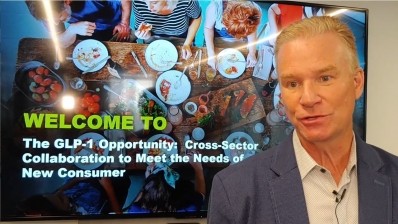ADM: 83% of GLP-1 users are ‘very interested in products specifically marketed as supportive of their needs on these drugs’

ADM’s supportive solutions platform includes five critical needs for consumers taking anti-obesity medications, including three while taking the drugs and two while discontinuing or reducing the prescriptions. All of them are matched with ingredients in ADM’s portfolio, including a wide range of plant-based proteins, fiber, probiotics, low-caloric sweeteners and more.
Together, these can help food and beverage manufacturers quickly innovate and enter a fast-growing and quickly-evolving market in which few CPG players currently operate, according to ADM.
“Globally the rates of overweight and obesity are really substantial. About 30% of the global population is actually overweight, and a lot of those people are seeking solutions for weight management,” leading to a dramatic rise in anti-obesity medications, including GLP-1 drugs, which a projected 9% of US adults may be on by the early 2030s, Brad Schwan, VP of marketing at ADM, told FoodNavigator-USA.
Alongside this surge in use of anti-obesity drugs is a new consumer group with distinct – and largely unmet – needs, he said.
“It really creates white space for food, beverage and dietary supplement manufacturers to create companion solutions that can help support users of GLP-1 drugs,” he explained.
What do GLP-1 users want from foods and beverages?
Anti-obesity drug users experience “a number of shifts” in how they experience hunger and food, including 78% of whom report feeling full more quickly, and 64% who say they have fewer cravings for sweet foods, Schwan said, citing insights from a survey of more than 1,500 people actively taking GLP-1 medications that ADM conducted.
The survey also revealed 83% of anti-obesity drug users are cooking at home more, which Schwan hypothesized is because they have more patience for prep time now that “food noise” or cravings are reduced.
“The away from home occasion allows you to access food more quickly. You can go from craving to enjoying more quickly than at home, where there might be more prep time involved. So, my hypothesis would be that [away from home] is a little bit more efficient, but they can wait a little bit more” when they are on the drugs, he said.
For potentially similar reasons, survey respondents reported snacking less while on GLP-1 drugs. ADM found 53% are snacking less during the mid-morning, 50% are snacking less in the mid-afternoon and 46% are cutting back late-night.
However, 74% of consumers report they are more open to trying new foods, which creates significant market opportunity – especially when paired with the 83% who report they are “very interested in products specifically marketed as supportive of their needs on these drugs,” Schwan said.
5 need states and solutions
These “needs” include five areas that ADM identified through the survey and work with “PhD experts,” which make the foundation of its new supportive solutions platform, Schwan said.
The first is maintaining muscle mass.
“When you are losing weight, 20% to 40% of the weight that you lose comes from muscle mass. That is a pretty substantial percentage,” and one that ADM can help food manufacturers address with its plant-based protein portfolio, including soy, pea and wheat proteins that can help promote the retention of lean muscle mass, Schwan said.
The second need state is minimizing gastrointestinal discomfort.
“About 40% of the consumers we surveyed said they had experienced GI discomfort while on GLP-1s, which is a meaningful percentage,” said Schwan.
“Some of the things that we can do to help as ADM is we have fibers, including prebiotic and dietary fiber, as well as pro- and postbiotics … with clinically documented results for supporting gut and digestive health. That is a critical consumer need we happen to be able to sponsor,” he said
Sufficiently hydrating is another top concern for GLP-1 users, according to ADM research, which found 44% of consumers reported feeling less hydrated.
“ADM can help promote hydration by making beverages more appealing” with its sweetener solutions and flavor modulation technology, Schwan said. It also offers coconut water powder to support hydration, he added.
The last two areas ripe for innovation to support GLP-1 users, according to ADM, focus on when consumers discontinue or ramp down their use of the drugs.
“The first one is around promoting satiety,” said Schwan. “When consumers are on these GLP-1 drugs, those persistent thoughts about food tends to be dampened a bit. And when you are discontinuing the drugs or ramping down, that food noise can ramp back up. And so, promoting satiety is a really important need.”
He explained that ADM’s Fibersol can help – citing a clinical study that found 10 grams of Fibersol taken when a meal can stimulate production of satiety hormones that are associated with delaying post meal hunger in healthy adults.
ADM’s resistant tapioca starch and plant-based ingredients also support satiety, he said.
Managing weight regain is the final need state that ADM identified and addresses in its platform.
Research shows ADM’s BPL1 postbiotic derived from its BPL1 probiotic strain can support reductions in total visceral fat and support a healthy waist circumference in combination with diet and exercise. It also supports metabolic health more broadly.
ADM’s sweetener solutions also can help deliver lower sugar offerings to help cut calories and meet demand for lower carb products, Schwan said. Likewise, the company’s proteins can help support weight management, he said.
Ready-to-go concepts: ‘ADM is prototyping in weeks, not months’
Recognizing that speed to market is important for companies hoping to meet consumer needs and shape this market, ADM’s platform includes 25 concepts that are ready to go and can be the base for rapid product development.
One example is a plant-based pudding that packs 20 grams of protein, including ADM’s pea protein, and another is a stick pack with 10 grams of Fibersol that can be added easily to food or drink.
“When we work with customers, it is a two-way dialog, and it is a co-creation process where we are developing together, all the focus on delight. What we bring to the table as ADM is we bring the best in class ingredient portfolio to meet these needs. We bring the full formula, product development expertise to the table, and then when we partner with our customers to create customized things that really are tailored to their brands and their specific consumer needs,” Schwan said.
He added, “Consumers are hungry for these solutions and brands are going to want to move quickly. To move quickly, you need to pick the right partner. You need to pick someone that has got the portfolio development expertise … and ADM is prototyping in weeks, not months.”


















